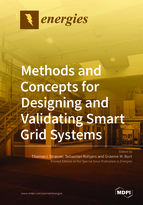Methods and Concepts for Designing and Validating Smart Grid Systems
A special issue of Energies (ISSN 1996-1073).
Deadline for manuscript submissions: closed (31 October 2018) | Viewed by 94416
Special Issue Editors
Interests: power utility automation; modelling and (real-time) simulation of smart grid systems; ICT for smart grids; validation and testing of smart grid systems; hardware-in-the-loop experiments
Special Issues, Collections and Topics in MDPI journals
Interests: ICT and automation for smart grids; modeling and co-simulation of smart grid systems; real-time simulation
Interests: distributed energy and smart grid protection and control; compact power systems for microgrid, aerospace and marine applications; experimental validation; systems testing and power-hardware-in-the-loop; DC distribution; hybrid power systems
Special Issues, Collections and Topics in MDPI journals
Special Issue Information
Dear Colleagues,
Energy efficiency and low-carbon technologies are key contributors to curtailing the emission of greenhouse gases that continue to cause global warming. The efforts to reduce greenhouse gas emissions also strongly affect electrical power systems. Renewable sources, storage systems and flexible loads provide new system controls but power system operators and utilities have to deal with their fluctuating nature, limited storage capabilities and typically higher infrastructure complexity with a growing number of heterogeneous components. In addition to the technological change of new components, the liberalization of energy markets and new regulatory rules bring contextual change that necessitate the restructuring of the design and operation of future energy systems. Sophisticated component design methods, intelligent information and communication architectures, automation and control concepts, new and advanced markets, as well as proper standards, are necessary in order to manage the higher complexity of such intelligent power systems that form the smart grid.
Due to the considerably higher complexity of such cyber-physical energy systems, constituting power system, automation, protection, information and communication technology (ICT), and system services, it is expected that the design and validation of smart grid configurations will play a major role in future technology and system developments. However, an integrated approach for the design and evaluation ofsmart grid configurations incorporating these diverse constituent parts remains evasive. Validation approaches available today focus mainly on component-oriented methods. In order to guarantee a sustainable, afforable and secure supply of electricity through the transition to a future smart grid with considerably higher complexity and innovation, new design, validation and testing methods appropriate for cyber-physical systems are required. Papers that present results related to the design and validation of smart grid systems are particularly welcome for this Special Issue.
Dr. Thomas Strasser
Prof. Dr. Sebastian Rohjans
Prof. Dr. Graeme Burt
Guest Editors
Manuscript Submission Information
Manuscripts should be submitted online at www.mdpi.com by registering and logging in to this website. Once you are registered, click here to go to the submission form. Manuscripts can be submitted until the deadline. All submissions that pass pre-check are peer-reviewed. Accepted papers will be published continuously in the journal (as soon as accepted) and will be listed together on the special issue website. Research articles, review articles as well as short communications are invited. For planned papers, a title and short abstract (about 100 words) can be sent to the Editorial Office for announcement on this website.
Submitted manuscripts should not have been published previously, nor be under consideration for publication elsewhere (except conference proceedings papers). All manuscripts are thoroughly refereed through a single-blind peer-review process. A guide for authors and other relevant information for submission of manuscripts is available on the Instructions for Authors page. Energies is an international peer-reviewed open access semimonthly journal published by MDPI.
Please visit the Instructions for Authors page before submitting a manuscript. The Article Processing Charge (APC) for publication in this open access journal is 2600 CHF (Swiss Francs). Submitted papers should be well formatted and use good English. Authors may use MDPI's English editing service prior to publication or during author revisions.
Keywords
- design, development and implementation methods for smart grid technologies
- modeling and simulation of smart grid systems
- co-simulation based assessment methods
- validation techniques for innovative smart grid solutions
- real-time simulation and hardware-in-the-loop experiments








